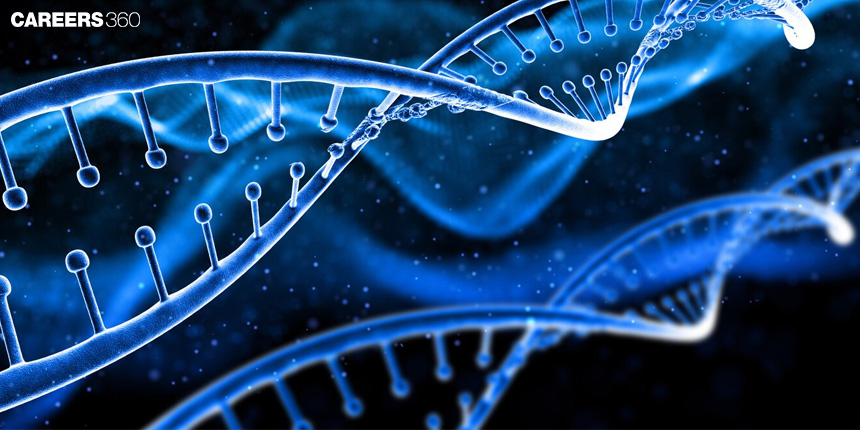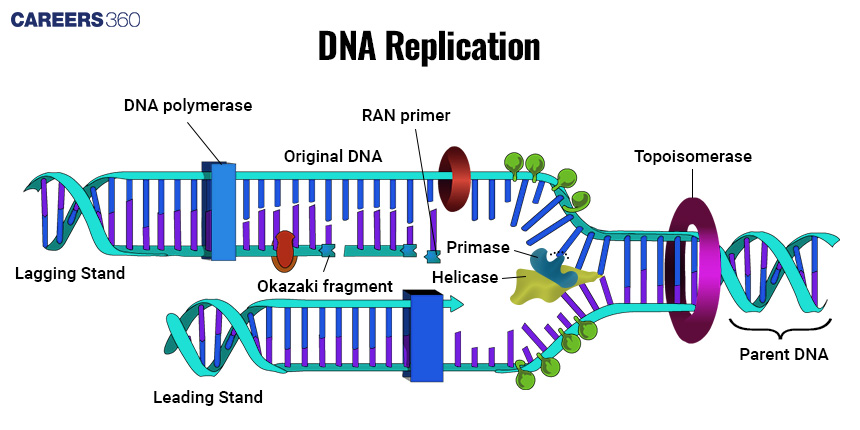Replication of DNA: Know Process and Diagram
DNA replication is the process by which DNA makes an identical copy of itself during cell division. It ensures that each new cell receives the same genetic information as the parent cell. DNA replication is essential for growth, repair, and reproduction in all living organisms. In this article, DNA replication, DNA structure, enzymes involved in DNA replication, steps of DNA replication, semi-conservative nature of DNA replication, and replication in prokaryotes vs eukaryotes are discussed. DNA Replication is a topic of the chapter Molecular Basis of Inheritance in Biology.
- What is DNA Replication?
- DNA Structure
- Enzymes involved in DNA Replication
- Steps of DNA Replication
- Semi-Conservative Nature of DNA Replication
- Replication in Prokaryotes vs Eukaryotes

What is DNA Replication?
DNA replication is a biological process by which a cell makes a duplicate copy of its DNA, essentially making two copies out of a single DNA molecule. This step is accomplished before cell division to ensure that the new cell produced at the end of the process has an exact, complete set of genetic material. Hence, DNA replication is the basis for life processes such as growth, development, and reproduction.
DNA Structure
The structure of the DNA molecule was elucidated by James Watson and Francis Crick in 1953. It was described as being a double helix very similar in structure to a twisted ladder. The backbone of this ladder was represented to be composed of a sugar-phosphate backbone, with the rungs represented by the nitrogenous base pairs: adenine with thymine (A-T) and cytosine with guanine (C-G).
The DNA strands are anti-parallel; they run in opposite directions. One runs 5' to 3', and another runs 3' to 5'. This orientation is important for replication, for the DNA polymerases can add nucleotides to the 3' end of the growing DNA strand only.
Enzymes involved in DNA Replication
DNA replication is facilitated and accurately done simultaneously due to the various roles played by different enzymes. These enzymes include:
Helicase: These open the double helix of DNA into two single-stranded templates.
Primase: These enzymes synthesise short RNA primers required for DNA polymerases to initiate nucleotide incorporation.
DNA Polymerase: Adds nucleotides to the growing DNA strand in a 5' to 3' direction. In prokaryotes, it is mainly DNA Polymerase III that synthesizes the new DNA while replacing RNA primers with DNA is done by DNA Polymerase
Ligase: Seals nicks and joins Okazaki fragments on the lagging strand to provide a continuous DNA strand.
Topoisomerase: Averts the DNA from supercoiling and tangling ahead of the replication fork.
Single-Strand Binding Proteins (SSBs): Bind unwound DNA strands to prevent them from reannealing.
Also Read-
Steps of DNA Replication
The mechanism of DNA replication consists of three main stages: initiation, elongation, and termination.
Initiation
Replication begins at specific regions of the DNA molecule known as the origins of replication. In these regions, the helix is unwound initially by helicase to generate a replication fork. The binding of single-strand binding proteins would stabilize the unwound DNA while RNA primers are made by a primase which acts as a starting point for actual DNA polymerases.
Elongation
During the process of elongation, DNA polymerase III adds nucleotides to synthesise the new DNA strands. The leading strand is continuously synthesized toward the replication fork while the lagging strand is synthesised in short segments called Okazaki fragments. As described earlier, these RNA primers are later replaced with DNA by DNA polymerase I and the Okazaki fragments are joined into a continuous strand by DNA ligase.
Termination
Replication is completed when the entire DNA molecule has been duplicated. In eukaryotes, the ends of linear chromosomes are capped by telomeres, which also prevent the loss of genetic material during replication. Telomerase, an enzyme, lengthens the end telomeres and enables the complete replication of chromosome ends.
Diagram: DNA Replication
The diagram below shows the process of replication in DNA.

Semi-Conservative Nature of DNA Replication
In the semi-conservative model for DNA replication put forward by Watson and Crick, each of the new DNA molecules contains one old strand and one newly synthesized strand. Experiments done by Meselson and Stahl supported this model by showing, after a single round of replication, that the DNA consisted of one old and one new strand associated with it, fitting the mechanism of replication as being semi-conservative.
Replication in Prokaryotes vs Eukaryotes
The replication process of prokaryotes and eukaryotes is mentioned below
DNA Replication in Prokaryotes :
Single origin of replication
Faster replication due to a simpler structure
Circular DNA
Fewer proteins involved
DNA Replication in Eukaryotes :
Multiple origins of replication
Slower replication due to complex chromatin structure
Linear DNA with telomeres
More controlling elements and proteins involved in the process
Also Read-
| Process of Translation in Biology | Gene Regulation and Gene Expression |
| Genes | Genetic Code And Mutation |
| Gene to Protein - Transcription and Translation | Protein Synthesis |
Recommended Video for Replication
Frequently Asked Questions (FAQs)
So that at the time of cell division, every new cell formed must get an identical copy of the DNA.
Whereas prokaryotes have one origin of replication and circular DNA, eukaryotes have multiple origins of replication and linear DNA with telomeres.
The main ones are the helicase, primase, DNA polymerase, ligase, topoisomerase, and single-strand binding proteins involved in the unwinding, synthesis, and stabilisation of DNA.
The semi-conservative model means that each new DNA molecule contains one old strand and one newly made strand.
DNA polymerase proofreads and edits its work during synthesis, and the remaining errors are repaired by the mismatch repair mechanisms.
Also Read
29 Nov'24 09:31 AM
19 Nov'24 09:26 AM
18 Nov'24 06:45 PM
18 Nov'24 09:29 AM
18 Nov'24 09:18 AM
18 Nov'24 09:01 AM
18 Nov'24 08:37 AM
16 Nov'24 03:45 PM

